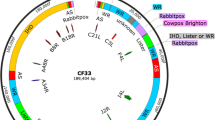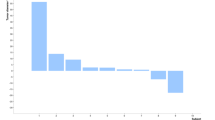Abstract
We conducted two phase 1 trials of direct intratumoral injection of a recombinant E1E3-deleted adenovirus (AdR) encoding either the bacterial enzyme β-galactosidase (Ad.RSVβgal) or interleukin 2 (IL2, AdTG5327) into primary nonsmall-cell lung cancers of 21 patients. We report here virus shedding and the duration of virus expression in the tumor after intrabronchial injection of 107, 108 or 109 PFU of adenovirus. The infectious AdR and the viral DNA were detected in PBL, plasma, stool and aerodigestive samples in a dose-dependent manner, since cell cultures and PCRs were found to be positive mainly for samples from patients who received the highest AdR dose (109 PFU). We detected β-galactosidase activity in the tumor biopsy samples of 66% of the patients, seemingly dose related, and only low levels of IL2 mRNA could be detected in tumor biopsy samples. E1 sequences were not detected by PCR in any of the PBL and bronchial samples collected after virus delivery, except in one patient. In this patient, E1 sequences were detected in PBL as well as in tumor biopsy samples collected at days 8, 30 and 60 and were correlated with longer β-galactosidase expression in tumor samples. PBL tested before and after virus delivery contained both E1 sequences indicating that they did not result from replication-competent adenovirus (RCA) E1 sequences present in the inoculum. In addition, only on the day of the injection was Ad.RSVβgal also detected in E1-positive PBL, indicating that virus replication in blood was very unlikely.
This is a preview of subscription content, access via your institution
Access options
Subscribe to this journal
Receive 12 print issues and online access
$259.00 per year
only $21.58 per issue
Buy this article
- Purchase on Springer Link
- Instant access to full article PDF
Prices may be subject to local taxes which are calculated during checkout


Similar content being viewed by others
References
Minna JD et al. Cancer of the lung. In: De Vita Jr VT, Hellman S, Rosenberg SA (eds). Cancer: Principles and Practice of Oncology, 3rd edn. Lippincott: Philadelphia, 1989, pp 591–705.
Drings P, Vogt-Moykopf I . Pulmonary resection following chemotherapy. In: Peters RM, Toledo J (eds). Current Topics in General Thoracic Surgery, Vol 2: Perioperative Care. Elsevier: Amsterdam, the Netherlands, 1992, pp 197–209.
Roth JA et al. A randomized trial comparing perioperative chemotherapy and surgery with surgery alone in resectable stage IIIA non-small-cell lung cancer. J Natl Cancer Inst 1994; 86: 673–680.
Fischer J et al. Induction chemotherapy with and without recombinant human granulocyte colony-stimulating factor support in locally advanced stage IIIA/B non-small cell lung cancer. Semin Oncol 1994; 21(Suppl 4): 20–27.
Nesbitt JC et al. Survival in early-stage non-small cell lung cancer. Ann Thorac Surg 1995; 60: 466–472.
Arriagada R et al. Competing events determining relapse-free survival in limited small-cell lung carcinoma. The French Cancer Centers’ Lung Group. J Clin Oncol 1992; 10: 447–451.
Stratford-Perricaudet L, Perricaudet M . Gene transfer into animals: the promise of adenovirus. In: Cohen-Haguenauer O, Borion M (eds). Human Gene Transfer, Vol 219. Libbey Eurotext: Montrouge, France, 1991, pp 51–61.
Roth JA et al. Retrovirus-mediated wild-type p53 gene transfer to tumors of patients with lung cancer. Nat Med 1996; 2: 985–991.
Nemunaitis J et al. Adenovirus-mediated p53 gene transfer in sequence with cisplatin to tumors of patients with non-small-cell lung cancer. J Clin Oncol 2000; 18: 609–622.
Roth JA et al. Gene therapy for non-small cell lung cancer: a preliminary report of a phase I trial of adenoviral p53 gene replacement. Semin Oncol 1998; 25(Suppl 8): 33–37.
Weill D et al. Adenoviral-mediated p53 gene transfer to non-small cell lung cancer through endobronchial injection. Chest 2000; 118: 966–970.
Swisher SG et al. Adenovirus-mediated p53 gene transfer in advanced non-small-cell lung cancer. J Natl Cancer Inst 1999; 91: 763–771.
Niklinska W, Burzykowski T, Chyczewski L, Niklinski J . Expression of vascular endothelial growth factor (VEGF) in non-small cell lung cancer (NSCLC): association with p53 gene mutation and prognosis. Lung Cancer 2001; 34(Suppl 2): S59–S64.
Masuya D et al. The intratumoral expression of vascular endothelial growth factor and interleukin-8 associated with angiogenesis in non-small cell lung carcinoma patients. Cancer 2001; 92(10): 2628–2638.
Asselin-Paturel C et al. Quantification of cytokine mRNA in human non-small cell lung cancers: local and peripheral IL-10 overexpression. Int J Cancer 1998; 77: 7–12.
Sterman DH et al. Adenovirus-mediated herpes simplex virus thymidine kinase/ganciclovir gene therapy in patients with localized malignancy: results of a phase I clinical trial in malignant mesothelioma. Hum Gene Ther 1998; 9: 1083–1092.
Goossens PH et al. The effect of promoter strength in adenoviral vectors in hyperplastic synovium. Clin Exp Rheumatol 2000; 18: 547–552.
Abken H, Butzler C, Willecke K . Adenovirus type 5 persisting in human lymphocytes is unlikely to be involved in immortalization of lymphoid cells by fusion with cytoplasts or by transfection with DNA of mouse L cells. Anticancer Res 1987; 7: 553–558.
Fox JP et al. The virus watch program: a continuing surveillance of viral infections in Metropolitan New York families. VI. Observations of adenovirus infections: virus excretion patterns, antibody response, efficiency of surveillance, patterns of infections, and relation to illness. Am J Epidemiol 1969; 89: 25–50.
Hillis WD, Cooper MR, Bang FB . Adenovirus infections in West Bengal. I. Persistence of viruses in infants and young children. Indian J Med Res 1973; 61: 980–988.
Tursz T et al. Phase I study of a recombinant adenovirus-mediated gene transfer in lung cancer patients. J Natl Cancer Inst 1996; 88: 1857–1863.
Stratford-Perricaudet LD, Makeh I, Perricaudet M, Briand P . Widespread long-term gene transfer to mouse skeletal muscles and heart. J Clin Invest 1992; 90: 626–630.
Lenett DA . Collection and preparation of specimens for virological examination. In: Murray PR, Baron EJ, Pfaller MA, Tenover FC, Yolken RH (eds). Manual of clinical Microbiology, 6th edn. American Society for Microbiology: Washington, DC, 1995; pp 868–875.
Bonnerot C et al. A beta-galactosidase hybrid protein targeted to nuclei as a marker for developmental studies. Proc Natl Acad Sci USA 1987; 84: 6795–6799.
Brossart P et al. A polymerase chain reaction-based semiquantitative assessment of malignant melanoma cells in peripheral blood. Cancer Res 1995; 55: 4065–4068.
Mc Donough M et al. PCR detection of human adenovirus. In: Pershing DH, Smith TH, Tenover FC, White TJ (eds). Diagnostic molecular microbiology. American Society for Microbiology: Washington, DC, 1993, pp 389–393.
Acknowledgements
We thank P Rovelon and all the nurses of the Gene Therapy Unit at the Institut Gustave Roussy for their contributions to this study and P Baldeyrou for bronchoscopies. We also acknowledge E Leclercq, MH Courtier, E Moec, S Chauvin, E Connault, N DiFalco and C Leboulaire for technical assistance and L Saint Ange and M Mackenthun for editing.
Author information
Authors and Affiliations
Rights and permissions
About this article
Cite this article
Griscelli, F., Opolon, P., Saulnier, P. et al. Recombinant adenovirus shedding after intratumoral gene transfer in lung cancer patients. Gene Ther 10, 386–395 (2003). https://doi.org/10.1038/sj.gt.3301928
Received:
Accepted:
Published:
Issue Date:
DOI: https://doi.org/10.1038/sj.gt.3301928



